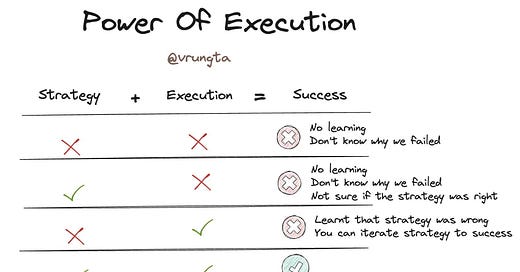The Power of Execution: Turning Strategies into Success
Strategy sets the direction, but execution determines the destination
In the world of product management, strategy and execution are the two pillars that support success. While a well-crafted strategy is essential, execution is the muscle that brings that strategy to life. The interplay between these elements determines whether a team thrives or flounders. Let's explore the nuances of this dynamic and understand why execution holds the key to success.
Strategy vs. Execution
The classic debate of strategy versus execution often surfaces in leadership discussions. However, this debate misses a crucial point: both are essential, but their contributions are not equal in all contexts. The diagram above illustrates four scenarios that result from different combinations of strategy and execution, highlighting the importance of execution in driving outcomes.
1. Poor Strategy, Poor Execution
When both strategy and execution are lacking, failure is inevitable. This scenario leads to no learning and an inability to identify the reasons for failure. Without a clear strategy, efforts are directionless. Without execution, even a clear strategy remains untested and theoretical.
2. Strong Strategy, Poor Execution
A robust strategy alone cannot guarantee success. Without execution, a great strategy remains a concept. Teams in this scenario face frustration as they are unable to bring their vision to life. The lack of execution means there's no learning, and the team cannot determine if the strategy was viable or not.
3. Poor Strategy, Strong Execution
Surprisingly, this scenario is more favorable than the previous one. Even with a poor strategy, strong execution enables learning. Teams can identify flaws in their strategy and iterate towards improvement. Execution provides tangible data and insights, allowing for strategic pivots and adjustments.
4. Strong Strategy, Strong Execution
This is the ideal scenario where success is most likely. A well-defined strategy, combined with effective execution, leads to desired outcomes. Teams not only succeed but also understand the elements that contribute to their success, allowing for continuous improvement and scaling of efforts.
The Learning Cycle: Execution as a Feedback Mechanism
Execution is not just about implementing a strategy; it's a critical feedback mechanism. Through execution, teams gather data, observe outcomes, and refine their approaches. This iterative process is essential for adapting to changing circumstances and improving strategies over time.
In scenarios where execution is strong, teams are better positioned to learn from their failures. They can pinpoint what went wrong and why, leading to more informed decisions in the future. Conversely, without execution, teams miss out on these valuable insights, leaving them in the dark about the effectiveness of their strategies.
Execution Muscle: Building a Resilient Team
Developing a strong execution muscle is akin to building resilience within a team. It ensures that even when strategies fall short, the team can adapt, learn, and pivot towards success. This resilience is crucial in the fast-paced, ever-evolving landscape of product management.
A team that excels in execution can test hypotheses quickly, learn from real-world outcomes, and iterate on strategies efficiently. This agility is a significant competitive advantage, allowing teams to stay ahead of market trends and customer needs.
Conclusion: Balancing Strategy and Execution
While strategy sets the direction, execution determines the destination. Both are indispensable, but execution plays a pivotal role in translating vision into reality. By fostering a culture of strong execution, teams can navigate uncertainties, learn from failures, and continuously improve their strategies.
In the end, the power of execution lies in its ability to turn theoretical strategies into tangible successes. It is the driving force that propels teams forward, enabling them to achieve their goals and make a meaningful impact. So, build your execution muscle, embrace the iterative process, and watch your strategies come to life.




